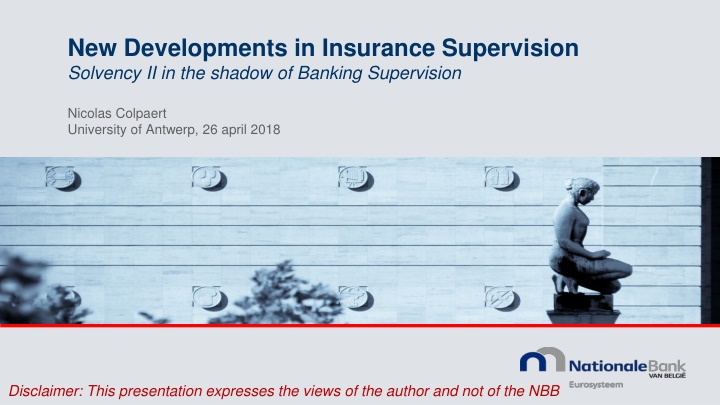
Insurance Supervision: Contrasts with Banking and Regulatory Frameworks
Explore the differences between insurance and banking business models, balance sheets, and regulatory frameworks, emphasizing the implications of Solvency II in the context of banking supervision. Delve into risk mutualization, capitalization, regulatory requirements, and more in this insightful presentation by Nicolas Colpaert at the University of Antwerp in 2018.
Download Presentation

Please find below an Image/Link to download the presentation.
The content on the website is provided AS IS for your information and personal use only. It may not be sold, licensed, or shared on other websites without obtaining consent from the author. If you encounter any issues during the download, it is possible that the publisher has removed the file from their server.
You are allowed to download the files provided on this website for personal or commercial use, subject to the condition that they are used lawfully. All files are the property of their respective owners.
The content on the website is provided AS IS for your information and personal use only. It may not be sold, licensed, or shared on other websites without obtaining consent from the author.
E N D
Presentation Transcript
New Developments in Insurance Supervision Solvency II in the shadow of Banking Supervision Nicolas Colpaert University of Antwerp, 26 april 2018 Disclaimer: This presentation expresses the views of the author and not of the NBB
Presentation outline Banking versus insurance Different business models Different balance sheets Different regulatory framework Entity-based versus Activity-based regulation Example: residential mortgage lending by banks vs. insurers 2
Banking versus insurance Different business models Banking Insurance Risk mutualisation and/or savings capitalisation Maturity transformation Business model Investment driven Liability driven (ALM) Short-term (deposits, interbank, debt) Stable funding (premiums, debt) Funding / Liquidity Liabilities more liquid than assets Inverse production cycle 3
Banking versus insurance Different balance sheets Source: Institute and Faculty of Actuaries 4
Banking versus insurance Different regulatory frameworks Banking CRD/CRR Insurance Solvency II Financial stability & Depositors protection Policyholder protection (ALM) & Financial stability Focus Solvency, liquidity, profitability requirements Leverage and large exposure limits Risk-weighted assets: Credit Market Operational Quantitative requirements (capital, valuation) Pillar I Solvency capital requirements: Counterparty default (credit) Market Operational Underwriting (life, non-life, health) Intangibles Comprehensive approach Adjustments (LAC DT, TP) & Diversification benefits Compartmented approach No adjustments & No Diversification benefits Supervisory review and evaluation process Supervisory review process, system of governance, risk management Pillar II Internal capital adequacy assessment process (ICAAP) Internal liquidity adequacy assessment process (ILAAP) Stress tests Own risk and solvency assessment (ORSA) Stress test (Belgian law) Market discipline (reporting & disclosure) Market discipline (reporting & disclosure) Pillar III 5
Entity-based versus Activity-based regulation Entity-based regulation Different entity different business model different regulatory requirements Risk of regulatory arbitrage (e.g. shadow banking) Activity-based regulation Same activity same risk same regulatory requirements Example: residential mortgage lending by banks vs. insurers 6
Residential mortgage loans: risk of regulatory arbitrage Differences between Solvency II and CRR capital req. for default risk Banks Insurers Capital req. for credit risk=RWA*SREP = 15%*LGD1 RWA typically calculated using IRB model. RWs are increased by NBB macropru buffer: RW_incl_buffer=5%+1,33*RW_excl_buffer. SREP: - P1: Pillar 1: equal to 4.5% for CET1 or 8% for total equity - CcoB: Capital conservation Buffer equal to 1.88% - O-SII: Other Systemically Important Institutions: bank-specific, varies from 0% to 1.5% - P2R: Pillar 2 Requirement: bank-specific, varies from 0% to 7.61% - P2G: Pillar 2 Guidance: bank-specific, varies from 0% to 3.25% Parameters LGD = max[loan value - 80%*mortgage value ; 0] 7 1(+90%*LGD_receivables past due>3months)
Residential mortgage loans: risk of regulatory arbitrage Differences between Solvency II and CRR capital req. for default risk For insurers, when residential mortgage loan has LTV <= 80% the counterparty default risk SCR is 0 Also, the probability of default does not impact the SCR 73% of mortgages held by banks have LTV <= 80% Highest arbitrage is therefore for mortgage loans with low LTV and high PD Furthermore: Insurers also benefit from diversification benefits when aggregating capital requirements (correlation matrix) The NBB has imposed additional macroprudential buffer for mortgage loans held by banks 8 1(+90%*LGD_receivables past due>3months)
Residential mortgage loans: risk of regulatory arbitrage Differences between Solvency II and CRR valuation Banks Insurers = Outstanding amount (IFRS 9) Solvency II value = Fair value (if no market value available) (IFRS 13) Valuation Outstanding amount does not cover interest rate payments Fair value is reduced to take into account expected losses, and also reduced by the NPV of the cap option and the prepayment option. Fair value also takes into account the time value of money (discounting) Impairments should be made to the outstanding amount to account for expected losses Remarks ???? ????? ??? = 1 + ??+ ??? ??? ???.?????? ???(???????.??????) ? In case the fair value of a mortgage is lower than the outstanding amount, this has a negative impact on the own funds of an insurer compared to the own funds of a bank. 9
Residential mortgage loans: risk of regulatory arbitrage IMF recommendation IMF FSAP 2018 recommendation: The NBB is recommended to set up a comprehensive monitoring framework for the risks arising from mortgage lending by insurers. Given the unusually high exposure of the sector towards real estate, the NBB should regularly analyze risk parameters of the loan portfolio, e.g., based on loan-to-value and debt-service-to-income ratios. Specifically, the potential for regulatory arbitrage between banks and insurers within a financial conglomerate should be duly explored. Should the NBB consider that the Solvency II Standard Formula does not adequately capture the risk profile of a company, e.g. due to large holdings in mortgage loans or due to a high concentration of the sovereign bond portfolio, the need for a Pillar 2 capital add-on should be assessed. 10
Residential mortgage loans: risk of regulatory arbitrage Way forward NBB is considering to roll-out two reportings to our Belgian insurers: 1. New residential mortgage loans reporting: Goal: address the IMF recommendation: Monitor the risks underlying the residential mortgages [focus on the key risks: default-, prepayment- and interest rate risk + some elements of the IFRS 13-valuation] Assess whether the capital buffers held are sufficient to cover the risks Assess to which extend mortgages fit within ALM context of insurer Scope of insurers: Insurers with >5% residential mortgages compared to their total investments Insurers with >5% residential mortgages compared to the total amount of mortgages held by BE insurers (hence >650 mio Euro) Scope of assets to be reported: All residential mortgage loans Macroprudential PHL reporting: Goal: monitor the Belgian residential mortgage loans market Scope of insurers: Insurers with >1 bn. Euro residential mortgages Scope of assets to be reported: Belgian residential mortgage loans 2. 11
Final considerations The Solvency II review tackles some of the unjustified inconsistencies between banking and insurance regulation E.g. Treatment of guarantees provided by regional governments, own funds, STS Residential mortgages were not part of the Solvency II review Entity-based regulation should be complemented by activity-based regulation to limit the risk of regulatory arbitrage Assess to which extend similar risks are treated differently across regimes (e.g. credit risk) Take into account interconnectedness and wider macro-economic impact (especially when designing macroprudential policy) 12




















